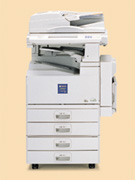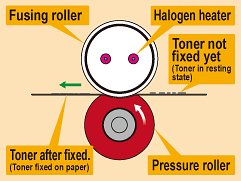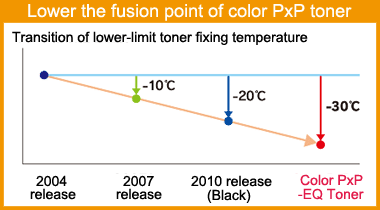- Home
- Sustainability
- Environment
- Environmental Information of Our Products
- Energy Conservation / Prevention of Global Warming –Preventing Global warming by saving energy–
Products:Energy Conservation / Prevention of Global Warming –Preventing Global warming by saving energy–
Evolution of energy-saving technologies used in copiers and multifunctional copiers
- To provide a product that can save energy yet be user-friendly and high quality -
·To realize a stress-free energy saving mode that is easy to use
 imagio Neo 350
imagio Neo 350
Although energy saving functions of multifunction copiers are now commonplace, what is really important for a multifunction copier to save energy?
Primarily, a multifunction copier stays idle in standby most of a day. For example, with one that prints 40-sheets/minute works for 20 days in an office outputting 50,000 sheets monthly, the time actually consumed for copying is only about one hour. It is in standby for about 95% of the time, so if we are to cut power consumption of multifunction copiers, we must suppress electrical consumption, not only in operation, but also in standby. That's why the energy saving mode was created.
That said, because the conventional energy saving mode requires a certain time before the device is ready to start copying, we felt customers might reject the power-saving mode. In today’s world of distinguished energy-saving technology, however, not to use it doesn’t make sense. In 1997, Ricoh started, on a full scale, to develop user-friendly energy-saving technologies that allow customers in busy offices to work stress free. The result is Ricoh's unique QSU (Quick Start-Up) energy-saving technology, which makes possible quick start up from energy saving mode; it was born in 1999. Imagio Neo350/450 (released in 2001) is equipped with this technology, which reduces start-up time to 10 seconds from the 30 seconds of the past. It won the Energy Conservation Grand Prize in the multifunction-copier field.
· Challenge a fixing technology to provide immediate warm up and transfer heat efficiently

Most of the electricity consumed by a multifunction copier goes to fixing the toner. In the printing process, images are formed on paper by powdered toner, which is dissolved with heat for fixing. The required temperature is 120 to180 degrees Centigrade.
QSU is a technology to bring a multifunction copier to life quickly from energy saving mode (sleeping state). The time to warm the fusing roller once it’s cold to the required temperature determines the start-up time. You may know of a recent home electrical appliance that instantaneously heats water the moment it’s switched on. This product does not, however, have a function to retain the temperature. The case is similar with a multifunction copier. Ricoh has promoted development for over 15 years, aiming at a multifunction copier that doesn't need heat retention. Roughly classified, there are two approaches to achieve quick start: (1) efficiently warm up the fusing roller and (2) reduce the heat required to dissolve toner.

· Two approaches to achieve quick start-up
(1) Efficiently warm up a fusing roller and (2) Reduce heat required to dissolve toner
(1) Efficiently warm up a fusing roller
Since the first generation QSU announced in 1999, the technology for efficiently warming up a fusing roller has evolved using electric storage capacitor technology for high-speed devices (the second generation). Furthermore, this technology employed IH fixing for color devices (the third generation) and now has evolved to reach the fourth generation. In the imagio MP C5002/C4002/C3302/C2802 series released in February 2012, we improved heat transmission efficiency by significantly lowering heat by reducing fixing belt thickness and diameter, while directly heating the fixing belt with a halogen heater. Furthermore, a fixing pad secures the contact width of the fixing belt with paper (toner), while enabling the reduction of the diameter of the fusing roller. With this configuration, heat equivalent to that produced by the conventional configuration is transmitted to the toner.
We employed the DH fixing system for high-speed (60 sheets/min.) devices in the “RICOH MP C6003/C5503/C4503/C3503/C3003” series released in June 2013 to drastically shorten the time needed for recovery from sleep mode.
(2) Reduce heat required to dissolve toner
· Devised a toner that dissolves at a low temperature and can reproduce high quality images
The fusing roller is primarily kept at a high temperature to dissolve toner. If the toner dissolves at a low temperature, the heat required for fixing becomes small.
The polymerization system, which is presently mainstream for processing color toners, allows toner production of smaller and more uniform particle size, as opposed to the conventional pulverization system of the past. With it, we can expect higher definition. When development of polymerized toners began, while all other companies were using styrene acrylic resin as the material, Ricoh looked into the future and dared to challenge the use of polyester resin, which was considered difficult to polymerize. Success resulted because polyester resin has high ecological performance, which is superior for low-temperature fixing.
Since the PxP toner using the polymerization system was released in 2004, we have further lowered the fusion point and have lowered the fixing temperature by about 30 degrees Centigrade (compared with the first PxP toner) in color PxP-EQ. It is used in the imagio MP C5002/C4002/C3302C2802 series (released in February, 2012). Beyond being excellent in ecological performance, this toner also achieves high definition, improving the color reproduction area by 10% compared with conventional toners.

The RICOH MP 6003 features these latest energy-saving technologies and has achieved improved typical electricity consumption (TEC) by 63% from 6.77kWh to 2.55kWh, compared with conventional devices. Never compromise on environment, user-friendliness and quality—these are the energy-saving technologies of Ricoh.






